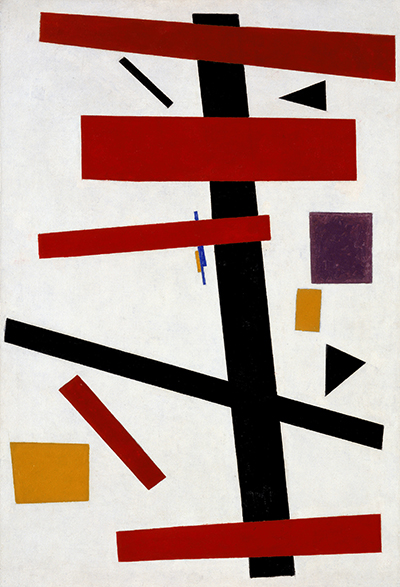Supremus No.50 dates from 1915 and at this point the artist, Malevich, was perfecting his Suprematist art style. It involved the use of squares and lines in simple abstract arrangements.
Malevich would demonstrate here his desire to reject reality entirely within his paintings by this stage of his career. He did not want people to bring pre-existing ideas or logic with them when they came across these various artworks. Instead, he wanted to create a new environment entirely, where one can let their imagination run free, seeing whatever they wanted to from the compositions in front of them. Here within this work we find two long black lines which are intercepted by smaller red lines. The angles are off from each other, with no consistency, promoting the idea of randomness in how the items appear. Additionally, there are then further shapes which sit on the outskirts, almost seemingly as an afterthought in order to fill some of the blank areas of the canvas. One must examine an artist's mind in order to understand such a high level of abstaction as this.
Russians were at the forefront of modern art within the first half of the 20th century, though in many cases they would actually have to move abroad in order to maximise their impact. Even Malevich had to leave many of his paintings in Germany in order to guarantee their survival once he became aware of issues regarding the promotion of modern art within the country. Ruling powers would clamp down on these modern ideas, and encouraged all artists to focus on the lives of the nation and within a more traditional artistic style.
This painting can be found in the collection of the Stedelijk Museum Amsterdam in the Netherlands. This important institution is famed for its collection of items from the career of Malevich and hosts many different paintings and drawings besides just Supremus No.50. For example, you will also find Woodcutter here, which is from his Cubist-Futurist period that occured just a few years earlier. He would devote himself to the lives of the working poor many times across his career, and this formed an important body of work, sitting alongside the highly abstract work as underlined by the artwork in front of us here. Aside from those important artworks within the gallery, you will also find the likes of George Hendrik Breitner, Paul Cézanne, Jean-Baptiste-Camille Corot, Gustave Courbet, Vincent van Gogh, and Johan Jongkind featured here as well.




